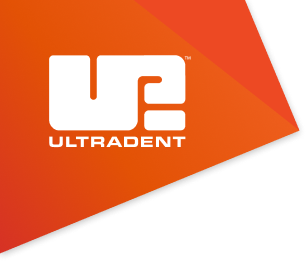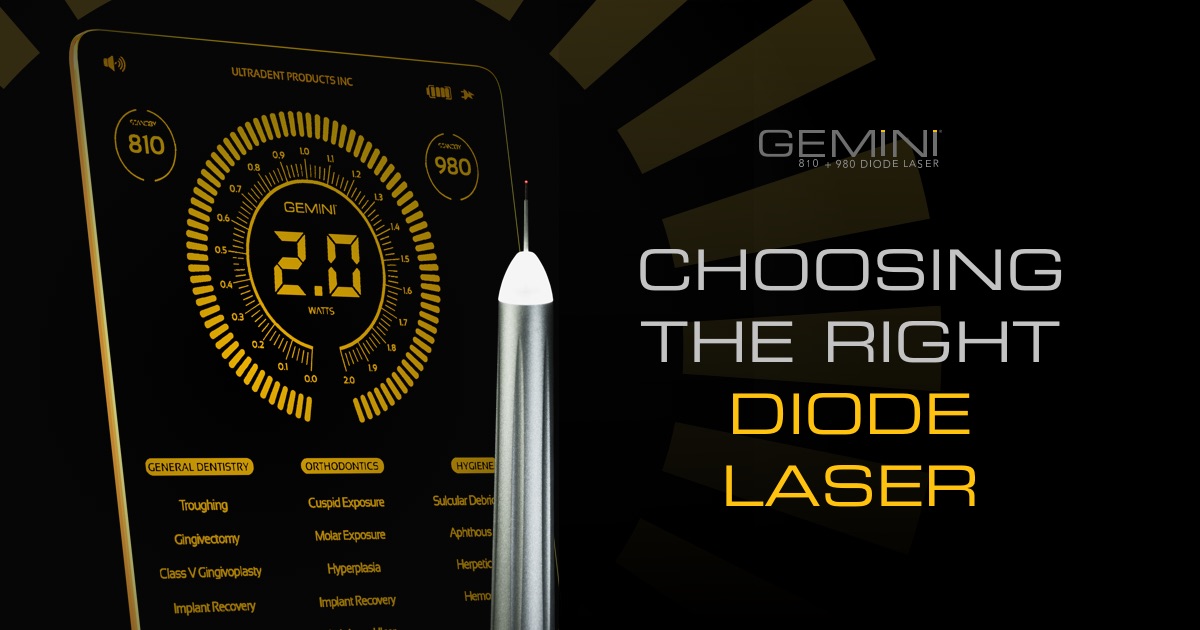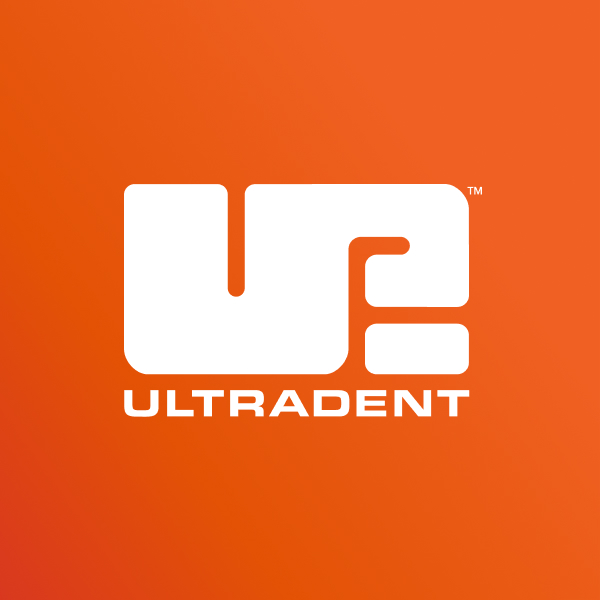1. Super-Pulsing Power
Power is important, and soft-tissue diode lasers come in a variety of power options. A laser’s power is essential to its ability to successfully perform any given procedure. The higher the peak power the laser offers, the faster and cleaner its cuts will be, which is the goal of laser dentistry. The Gemini® 810 + 980 dual wavelength diode laser from Ultradent provides an amazing 20 watts of peak power for efficient and effective procedures.
![]()
![Gemini super-pulsing[1]](https://blog.ultradent.com/hs-fs/hubfs/Sharepoint%20Blog%20Photos%20and%20Images/Images/Lists/Posts/AllPosts/Gemini%20super-pulsing%5B1%5D.jpg?width=672&name=Gemini%20super-pulsing%5B1%5D.jpg)
Tissue lasered with a non-pulsing diode laser (left) vs the Gemini® 810 + 980 dual wavelength diode laser
But power isn’t the only thing that clinicians should look for when purchasing a laser. The method in which the power is emitted is also extremely important to consider when shopping for a diode laser. That’s where super-pulsing power comes in! With continuous-power lasers, the laser is on and cuts the entire time it is in use. In contrast, a super-pulsed laser fires 50 times a second, turning off between each pulse. Because of the “cool down” that results between each pulse, known as thermal relaxation, a super-pulsed laser like the Gemini laser can operate at a much higher peak power (up to 20 watts) without charring, dragging, tagging or damaging the patient’s tissues. This results in less pain and much quicker recovery times.
![]()
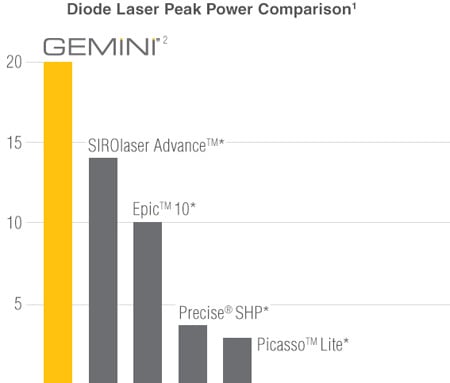
The Gemini laser’s peak power compared with top dental diode lasers on the market.
*SIROLaser AdvancedTM is a trademark of Sirona Dental; EPICTM 10 is a trademark of Biolase, Inc.; Precise® is a trademark of CAO Group, Inc.; PicassoTM is a trademark of AMD Laser.
1. Data published by manufacturer
2. Peak power in dual wavelength mode.
2. Wavelength
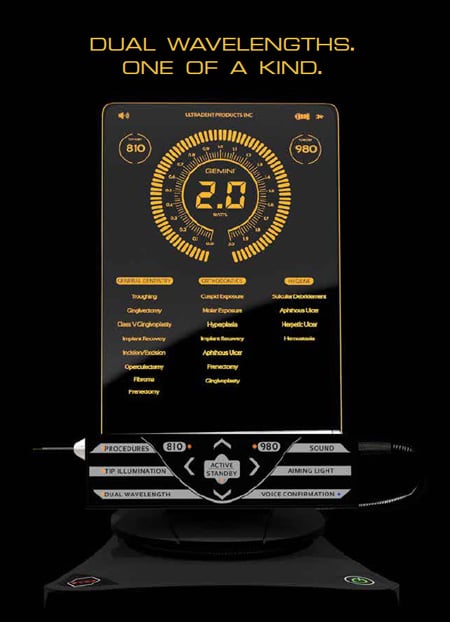
The Gemini laser offers both 810 nm and 980 nm wavelengths
Generally, diode lasers are offered in either 810 nm wavelengths or 980 nm wavelengths. These different wavelengths affect skin pigmentation and water absorption properties in different ways. For example, an 810 nm wavelength laser is optimal for melanin absorption, while a 980 nm wavelength works better for water absorption. Why risk buying a laser that operates at one wavelength, only to find out that you need another? You don’t have to. A dual-wavelength laser like the Gemini laser provides clinicians with greater versatility to better meet all patient’s varying needs by providing both 810 nm and 980 nm wavelengths in one laser.
3. Ease of Use
 The Gemini laser’s illuminated tip aids in clinician visibility
The Gemini laser’s illuminated tip aids in clinician visibility
No one wants to invest in a high-tech piece of equipment like a soft-tissue dental laser, and then struggle to figure out all optimal settings for the wide-variety of procedures it can perform. Look for a laser with features that simplify your procedures, like preprogrammed settings and a simple user interface. Built-in features like these will save you frustration, time, and money with every use. Ultradent’s Gemini diode laser offers 19 preset procedures that are ready to go at the touch of a button, plus the added bonus of an illuminated LED tip to ease visibility during your procedure.
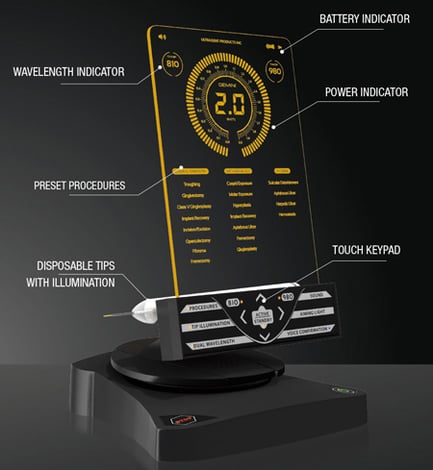 The Gemini laser's features are built around ease of use for the clinician
The Gemini laser's features are built around ease of use for the clinician
4. Service & Support After the Sale
A significant equipment investment like a diode laser should always be backed, not only by a solid warranty, but also with excellent software, training, and troubleshooting support. The Gemini laser comes with after-sale support that includes in-person training, online resources, support hotlines staffed by real people, and the option for additional training through the Academy of Laser Dentistry at a discounted rate. In fact, troubleshooting with the Gemini laser is often as easy as plugging it into your computer USB port for remote diagnostics and troubleshooting!
5. Quality and Affordability
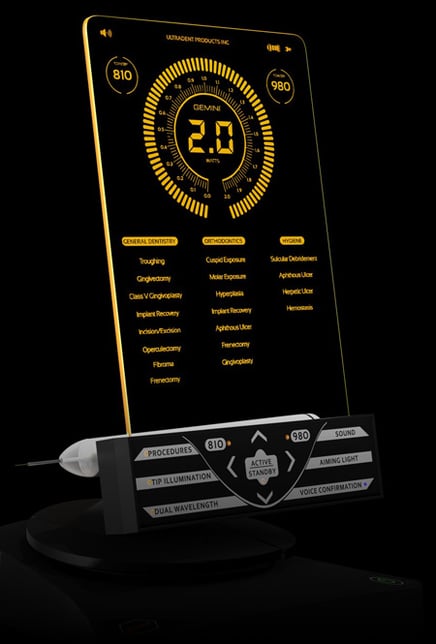 Gemini® 810 + 980 dual wavelength diode laser
Gemini® 810 + 980 dual wavelength diode laser
Far too often shopping for quality means breaking the bank. Most diode lasers used to be well over $10,000. Ultradent’s Gemini diode laser is affordably priced at about $7,000. The Gemini laser is an investment that is easy to justify because of the many procedures you can perform such as:
- Excisional and incisional biopsies
- Exposure of unerupted teeth
- Frenectomy
- Frenotomy
- Gingival troughing for crown impression
- Gingivectomy
- Gingivoplasty
- Gingival incision and excision
- Hemostasis and coagulation
- Implant recovery
- Abscess incision and drainage
- Laser soft tissue curettage
- Leukoplakia
- Operculectomy
- Oral papillectomies
- Pulpotomy
- Pulpotomy as an adjunct to root canal therapy
- Reduction of gingival hypertrophy
- Soft tissue crown lengthening
- Sulcular debridement (removal of diseased, infected, inflamed, and necrosed soft tissue in the periodontal pocket to improve clinical indices including gingival index, gingival bleeding index, probe depth, attachment loss, and tooth mobility)
- Treatment of canker sores, herpetic, and aphthous ulcers of the oral mucosa
- Vestibuloplasty
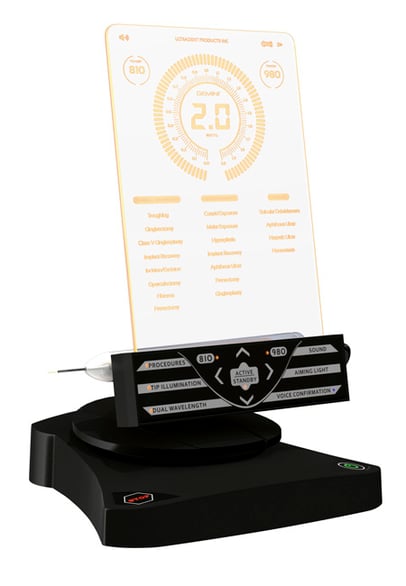 Not only is the Gemini diode laser the latest in dental laser technology with its dual-wavelength diode, but it’s also affordable.
Not only is the Gemini diode laser the latest in dental laser technology with its dual-wavelength diode, but it’s also affordable.
If you’re thinking about purchasing a diode laser for your dental practice, learn more about the Gemini® 810 + 980 dual wavelength diode laser here.

